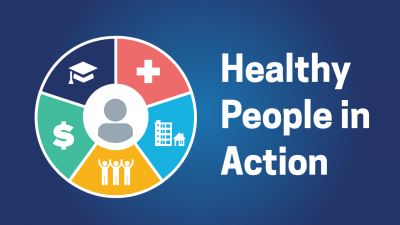This post is part of Healthy People in Action, a blog series highlighting how key stakeholders use the Healthy People framework in their work, form cross-sector collaborations, and address social determinants of health to help achieve health equity.
At the Center for Advancing Research in Transportation Emissions, Energy, and Health (CARTEEH), cross-sector collaboration is key. CARTEEH’s work focuses on how transportation infrastructure and emissions affect human health — bringing transportation and health professionals together to tackle high-priority projects.
CARTEEH’s efforts to improve health by addressing transportation issues make it an important stakeholder for Healthy People 2030 — which shares CARTEEH’s commitment to cross-sector partnerships.
“At CARTEEH, we’re excited about the ways we can collaborate with and contribute to the Healthy People initiative,” says CARTEEH Director Joe Zietsman, PhD. “When transportation experts work together with health professionals, it’s tremendously synergistic and helps us solve problems that we couldn’t successfully address on our own.”
Improving Health Through Transportation Research
- Texas A&M University, which leads the consortium
- Johns Hopkins University
- Georgia Institute of Technology
- University of Texas at El Paso
- University of California, Riverside
CARTEEH researchers collaborate on a wide range of projects that explore the relationship between transportation and health. For example, in one of CARTEEH’s first major projects, researchers studied how air pollution — including traffic emissions — affected the health of pregnant people and their children both before and after birth.
CARTEEH has also developed a conceptual model of 14 pathways, or links, between transportation and health outcomes. Some of the pathways, like green spaces, are beneficial to health. Others, such as air pollution and noise, can harm health.
The pathways model serves as a framework for research that supports strategies and policies to improve health. Because people in disadvantaged communities are often disproportionately affected by pathways that can harm health, the model also serves as a framework for research aimed at reducing health disparities.
Zietsman notes that the 14 pathways are directly connected to many Healthy People 2030 objectives, including those related to environmental health, injury prevention, physical activity, and respiratory disease. “We believe that CARTEEH’s research and the tools and technologies we develop will help advance progress toward achieving Healthy People’s transportation-related objectives, reducing health disparities, and advancing health equity,” he says.
Moving Beyond Research
Though research is a core part of CARTEEH’s work, that work doesn’t end when a research report is published.
“Our goal is always to make sure that our research isn’t just a series of reports collecting dust on a shelf,” says Yanzhi (Ann) Xu, PhD, Assistant Director of Technology at CARTEEH. “We make our findings and data accessible so people can apply them in their own work, and we work with stakeholders to make sure the technologies we develop actually go to market.”
Through events including seminars and webinars, CARTEEH spreads the word about its research findings. It also provides a large amount of data through 2 platforms:
- The CARTEEH Data Hub, which includes research results and data sets from researchers both within and outside CARTEEH, as well as links to other data repositories
- The Platform to Assess Transportation, Health, and Sustainability (PATHS), formerly known as TEMPO, which uses Houston and El Paso, Texas, as case studies to illustrate how changes in the transportation system affect emissions and pollution
In addition, CARTEEH applies its research findings in real-world projects with its partners.
“Our work has a bigger impact when we collaborate with other like-minded organizations,” Xu says. “Together, we can increase public awareness about the huge impact of transportation on health and make collective progress toward achieving the Healthy People 2030 vision of health and well-being for all people.”
Making SMART Decisions for Better Health
CARTEEH recently launched the Healthy People Through SMART Infrastructure initiative. Despite the name, the initiative isn’t part of Healthy People 2030 — though CARTEEH was motivated to start the initiative after conversations with ODPHP about how they can work together to improve health nationwide.
The SMART initiative provides a framework to help transportation planners develop infrastructure goals that are SMART. Different from the SMART goals many businesses use in organizational planning, these transportation-specific goals are sustainable, multimodal, accessible, resilient, and technological. Ultimately, the purpose of SMART goals is to result in better health outcomes.
Through the SMART initiative, CARTEEH is helping stakeholders assess the health and environmental benefits of actions such as:
- Using more electric vehicles at the Port of Houston for transporting goods over short distances and handling cargo
- Transforming an interchange in Dallas’ Southwestern Medical District into a boulevard with walkable public areas and green space
- Adding managed lanes for high-occupancy vehicles and enhancing bike and walking paths as part of a large highway improvement project in Austin, Texas
Zietsman says he’s excited about CARTEEH’s role in these projects, especially the opportunity to help transportation planners make decisions that can benefit public health. He notes that this work aligns with many Healthy People 2030 objectives and overarching goals.
“We’re looking forward to working on more projects like these as the decade advances,” Zietsman says. “The more that transportation and health professionals work together, the more we can make progress toward Healthy People goals — and ultimately improve the nation’s health.”
Disclaimer: This blog series highlights the activities of independent non-federal organizations that work with Healthy People data. Although ODPHP’s policies and programs may inform the work of such organizations, ODPHP does not direct or endorse activities of those organizations.




